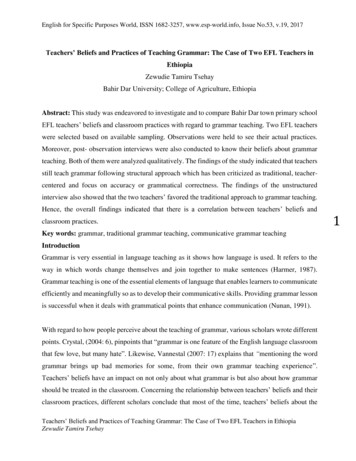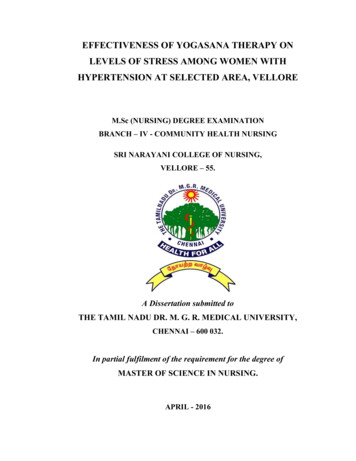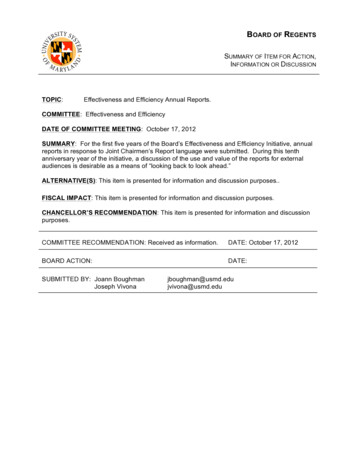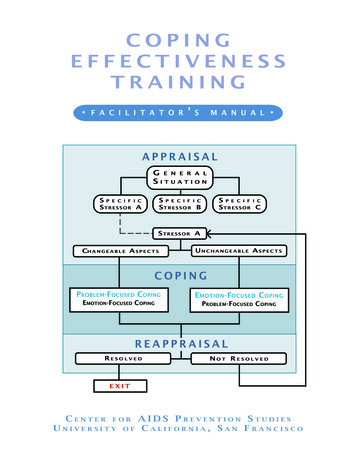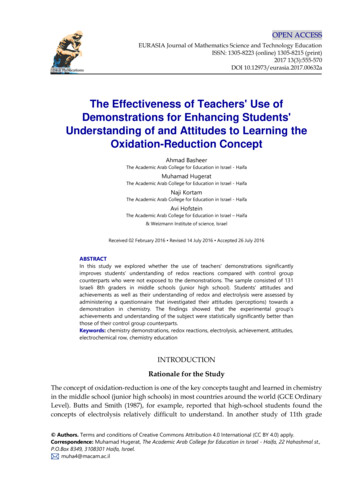
Transcription
OPEN ACCESSEURASIA Journal of Mathematics Science and Technology EducationISSN: 1305-8223 (online) 1305-8215 (print)2017 13(3):555-570DOI 10.12973/eurasia.2017.00632aThe Effectiveness of Teachers' Use ofDemonstrations for Enhancing Students'Understanding of and Attitudes to Learning theOxidation-Reduction ConceptAhmad BasheerThe Academic Arab College for Education in Israel - HaifaMuhamad HugeratThe Academic Arab College for Education in Israel - HaifaNaji KortamThe Academic Arab College for Education in Israel - HaifaAvi HofsteinThe Academic Arab College for Education in Israel – Haifa& Weizmann Institute of science, IsraelReceived 02 February 2016 Revised 14 July 2016 Accepted 26 July 2016ABSTRACTIn this study we explored whether the use of teachers' demonstrations significantlyimproves students’ understanding of redox reactions compared with control groupcounterparts who were not exposed to the demonstrations. The sample consisted of 131Israeli 8th graders in middle schools (junior high school). Students' attitudes andachievements as well as their understanding of redox and electrolysis were assessed byadministering a questionnaire that investigated their attitudes (perceptions) towards ademonstration in chemistry. The findings showed that the experimental group'sachievements and understanding of the subject were statistically significantly better thanthose of their control group counterparts.Keywords: chemistry demonstrations, redox reactions, electrolysis, achievement, attitudes,electrochemical row, chemistry educationINTRODUCTIONRationale for the StudyThe concept of oxidation-reduction is one of the key concepts taught and learned in chemistryin the middle school (junior high schools) in most countries around the world (GCE OrdinaryLevel). Butts and Smith (1987), for example, reported that high-school students found theconcepts of electrolysis relatively difficult to understand. In another study of 11th grade Authors. Terms and conditions of Creative Commons Attribution 4.0 International (CC BY 4.0) apply.Correspondence: Muhamad Hugerat, The Academic Arab College for Education in Israel - Haifa, 22 Hahashmal st.,P.O.Box 8349, 3108301 Haifa, Israel.muha4@macam.ac.il
A. Basheer et al.State of the literature Most of the studies on demonstrations are general, namely, comparing students usingexperimentations with teachers' demonstrations, covering a wide range of topics and concepts,less of these studies discuss the effectiveness of demonstrations.Few studies highlight that good demonstrations can enhance students' understanding,motivation, and attitudes.Demonstration in chemistry may be defined as a pedagogical event whose objective is toillustrate a scientific concept.The literature state that high percent of the students considered oxidation-reduction andelectrolysis is one of the most difficult concepts.Contribution of this paper to the literature This study concentrates on demonstration's effect on students' achievements and attitudes in aspecial sector "the Arab sector in Israel".Increasing the spectrum of studies on demonstrations in the redox and electrolysis reactions inwhich support the literature that well planned properly demonstrations lead to improvement inthe achievements and efficiency students.Based on students’ interview results, demonstration affected them very positively, brought theseredox concepts closer to their hearts, increased the extent of interest and attractiveness, andincrease their level of motivation and satisfaction. Hence, it can serve as an effective platform forenhancing students’ understanding of certain chemistry concepts.students conducted in Nigeria, Okpala and Onocha (1988) found that fifty percent of thestudents considered electrolysis one of the most difficult concepts. In a report by theCambridge University Local Examination Union concerning the achievements of studentsfrom Singapore in GCE O Level chemistry exams, it was noted that concepts related toelectrochemistry and electron transfer are associated with severe learning difficulties and withmisconceptions (Tan, 2000).As mentioned before, oxidation-reduction is one of the most important concepts withinthe topic of chemical reactions taught in middle school. Gillespie (1997) stated that chemicalreactions (including redox reactions) are one of the six key concepts in chemistry. Based onthis premise, it was decided to investigate the learning and understanding of the concept byusing classroom demonstrations. In this study we created a pedagogical intervention in orderto help students better understand the concepts of oxidation-reduction and electrolysis, whichare considered as difficult concepts in chemistry. The main goal of the current study was toinvestigate the educational effectiveness of using demonstrations in the context of teachingand learning the concept of oxidation-reduction in secondary school chemistry.More specifically, the main objectives of the current study are as follows:556
EURASIA J Math Sci and Tech Ed To explore the effectiveness of demonstrations regarding students' understandingof the oxidation reduction concept;To explore whether demonstrations improve students' attitudes toward chemistryand increase their motivation to learn science.THEORETICAL BACKGROUNDThe issue of using demonstrations (to be defined later) in a chemistry classroom hasoften been discussed in the research literature (Hofstein & Lunetta, 1984; Bare, & Andrews,1999; Thompson & Soyibo, 2002). Among the questions posed in the literature, we found thefollowing: Are demonstrations as effective as individual students' experimentations? Dodemonstrations promote the understanding and internalization of scientific concepts? Candemonstrations develop students' thinking skills? And what conditions are needed to maketeachers' demonstrations more effective than individual students' experimentations?Although lecture demonstrations have been conducted in chemistry classrooms for a longtime, little research exists that documents the frequency that such demonstrations areemployed or their effect on learners' motivation and performance (Price & Brooks, 2012; Odom& Bell, 2015). Shakhashiri (1992) remarked that "Educators have often searched for variousways to teach science". The use of demonstrations is one of numerous pedagogicalinterventions that have been adopted for enhancing students’ interest. Experiments anddemonstrations that confirm a physicochemical phenomenon such as illustrating chemicalprocesses by light-sticks (Kuntzleman, Rohrer & Schultz, 2012) can be used to facilitateunderstanding certain chemical concepts, for example, acid-base reactions, redox reactions,fluorescence, quantum chemistry, and thermodynamics.A demonstration involves illustrating a point in a lecture or a lesson by means ofsomething other than routine visual aids or other means of instruction. A demonstration inchemistry may be defined as a pedagogical event whose objective is to illustrate a scientificconcept (Taylor, 1988). This definition can be broadened and divided into three categories: (1)Visual aids used in an unusual manner, for example, teachers and students using bodymovements to illustrate acid/base chemistry and oxidation/reduction; another examplewould be Lomax's (1994) kinetic class, in which movement is used to reinforce the concept ofchemical transformations. (2) Analogical demonstrations, in which one uses a phenomenonwhose behavior is similar in relevant aspects to that of the scientific concept under discussion.A good example of this would be the use of steel balls on the glass cover of a watch to illustratethe density of atoms in a pseudo-metallic structure. (3) Real experiments, which are the mostcommon type of demonstration: Shakhashiri presents numerous examples in his fivepublished books (1983, 1985, 1989, 1992 & 2011). According to Chiappetta and Koballa (2002)and Shakhashiri (1992), well prepared and properly presented demonstrations have thepotential to enhance students' understanding of chemistry concepts. Similarly, Hofstein andLunetta (1982, 2004), in their comprehensive reviews, came to the conclusion thatdemonstrations have the potential to enhance learning, motivation, and attitudes.557
A. Basheer et al.Gardner (1978) suggested that demonstrations may enable learners to evoke the “wow”experience. This consequently can increase their curiosity and enhance their reasoningabilities. In addition, it may have an impact on students’ achievements (Gerber, Cavallo &Marek, 2001). Moreover, there are occasions in which teachers' demonstrations areeducationally more effective than are students' own experimentations (Hofstein & Lunetta,2004, Lunetta, Hofstein & Clough, 2007). Although research on the effectiveness ofdemonstrations has been conducted since the early 1960s, most of the studies were general,namely, comparing students using experimentations with teachers' demonstrations, coveringa wide range of topics and concepts. A number of research papers reported clear benefits whendemonstrations are used for teaching the sciences. In a study on college introductory physicscourses, Buncick, Betts, and Horgan (2001) found that demonstrations encouragegeneralization because they promote active participation on the part of the students. Anelevated level of student attention and involvement in tasks has also been reported fordemonstrations carried out in high-school chemistry courses. For example, Meyar et al. (2003)have shown that demonstrations encourage student involvement, since they are less teacheroriented and give students an opportunity to produce questions and to become more active inthe learning process. This in turn can motivate students to undertake an initial inquiry andalso provides a learning opportunity, because it helps create mental links between new andprevious learning. In addition, Meyar et al. reported that students can illustrate cognitivestrategies by observing the teacher as he thinks out loud while doing the demonstration andas he formulates questions that lead to an explanation of the concepts in question. This maychallenge students' preexisting understanding and can encourage perceptual understanding.The traditional teaching strategy of using a lecture-type approach may perhaps befavored by those students who are in favor of the didactic methods of learning and who areconsidered conscientious (Hofstein & Kempa, 1985; Kempa & Diaz, 1995). Demonstrations inuse as a teaching strategy may prove beneficial for students with different or special learningneeds. It is assumed that, when combined with traditional methods, demonstrations can beeffective for low-achieving students with high visual and spatial intelligence but with limitedcognitive abilities (Meyer et al, 2003; Rade, 2009; Baddock & Bucat, 2008). Althoughconsiderable research has been conducted on the use of demonstrations to teach chemistry,few studies have focused on how effective this method is in promoting cognitive involvement.Hofstein et al. (2005) and Dkeidek, Mamlok-Naaman, and Hofstein (2012) published a studyon question asking as a tool for developing high-order thinking skills in the chemistrylaboratory. They showed that students in the Jewish sector in Israel ask more questions thantheir Arab conterparts. This may result from a lack of knowledge in this area, which in turn,may be one of the reasons why it has been so difficult to justify the allocation of teacher timeand resources for demonstrations. Furthermore, the use of demonstrations as ateaching/learning technique has not been sufficiently studied in terms of how well itpromotes, challenges, and helps develop children's conceptual understanding.558
EURASIA J Math Sci and Tech EdIn addition, demonstrations could be conducted by the chemistry teachers as a methodof triggering a discussion between groups of students, which can be termed cooperativelearning. This approach is an educational learning technique whereby students collaborate insmall groups on a certain task, project, or argumentation. Towns & Grant (1997) noted that inorder to develop significant learning, students must process information actively. Cooperativelearning activities can create an environment in which students actively pursue their tasks bysharing insights, ideas and representations, providing feedback, and by teaching each other.The latter is also very consistent with studies that show that demonstrations in scienceencourage generalization because they promote active involvement by students and alsoenhance students' attention level. It may also be beneficial to include elements of cooperativelearning in demonstration lessons, in order to improve students' understanding of what istaught (Eilks, Prins & Lazarowitz, 2013).Research questionsThe purpose of this study is to examine how teaching and learning chemistry usingdemonstrations influences students' understanding of the topic of oxidation-reduction and itsrelated concepts. More specifically, the two research questions of interest are as follows:1. Are there significant differences in students' perceptions of the efficiency andimportance of demonstrations between those students who experienceddemonstrations in the teaching of oxidation-reduction and those who did not?2. Are there significant differences in students' achievements between students wholearned with and those who learned without demonstrations?METHODS AND RESEARCH SAMPLEThe nature of demonstrations that were developed and implemented in theexperimental classA series of demonstrations were used to illustrate the concepts of oxidation-reductionand electrolysis to be taught. The following demonstrations were chosen: Opening demonstration: Steel wool in a copper sulfate solution and copper in asilver nitrate solution.Various metals in a solution of other metallic ions in order to demonstrate anddiscuss the electrochemical row.Electrolysis of a copper chloride solution.Electrolysis of water – by using Hoffman's apparatusThe student sampleThe participants in this study consisted of two groups: an experimental (N 64) and acontrol (N 67) group, each consisting of two classes. All four classes (8th grade) were from thesame high school in an Arab educational sector located in the northern part of Israel. Both559
A. Basheer et al.groups had similar achievement scores and both had a heterogeneous distribution ofachievement levels according to a mapping test in chemistry (see Table 2).The experimental group studied oxidation-reduction using the traditional methodaccording to the Israeli curriculum in which a long teaching and learning sequence andrelevant demonstrations were introduced by the teachers. The control group studiedoxidation-reduction the same way, but with no demonstrations. Both groups were taught byan experienced chemistry teacher.Research InstrumentsThe attitude questionnaire: The student perception of a chemistry questionnaireconsisted of 10 items formulated using a five-point Likert-type scale where 1 strongly agreeand 5 strongly disagree (see appendix 1). The questionnaire was adapted from that ofMajerich & Schmucklet (2007) and modified for the present study (Cronbach's α 0.78).Multiple-choice test: The test consisted of a preliminary array of 15 multiple-choicequestions on the topics of oxidation-reduction and electrolysis, each with four possibilities(answers). The questions were taken from a variety of different sources (chemistry textbooks,chemistry exercise books, and test questions from previous years) and adapted to their presentpurpose. The test was content validated by two experts with a chemistry and science educationbackground. Both experts suggested changes in the formulation and requested replacing threequestions in order to have a variety of questions at different levels according to Bloom'staxonomy. Esiobu and Soyibo (1995) argue that for test items to effectively assess students'comprehension of scientific concepts they must go beyond the comprehension level in Bloom'staxonomy.Here is a sample question from the test:What happens when water undergoes electrolysis?A. Negative hydrogen is attracted to the anode and negative oxygen is attracted to thecathode and both become neutral elements.B. Positive hydrogen is attracted to the anode and negative oxygen is attracted to thecathode and both become neutral elements.C. Hydrogen gas is produced on the cathode and oxygen is produced on the anode andthe ratio of hydrogen: oxygen is 2:1.D. Hydrogen gas is produced on the anode and oxygen is produced on the cathode andthe ratio of hydrogen: oxygen is 1:2.Oral interviews: In addition to the quantitative data generated through the achievementtest and the attitude questionnaires, a structured interview was conducted with a sample ofstudents from the experimental group. The interview was semi-structured in which all thosewho were interviewed were asked the same questions. The interview focused on the following560
EURASIA J Math Sci and Tech Edaspects: students' understanding of the related subject matter, their satisfaction, their attitudetowards learning chemistry, their interest in science, and motivation.Research procedure: Figure 1 is a schematic outline illustrating the various activities andassessment procedures used in the two groups.Figure 1. A schematic presentation of the research study: A time line scheme561
A. Basheer et al.In both groups an opportunity was given for establishing a dialogue and for askingquestions during the lessons, but we found that in the experimental group the dialogue wasmore dynamic and more questions were asked. Moreover, in the experimental group moreactive student-teacher interactions during the demonstration lessons were detected than in thetraditional lessons. It is important to note that in the control group, in both classes, pupilsexpressed a desire to present their experiments related to or based on the idea ofelectrochemical row electrolysis in ionic solutions. The demonstration's efficiency and theimportance of the variable were calculated as the mean of students' answers in thequestionnaire by testing for students' perceptions of the demonstration's efficiency andimportance. Each student received a grade between one and five, with a higher gradeindicating that the student perceived the demonstrations as being more efficient and importantfor learning. The comprehension and achievement variable was measured by the students'grades on the test.FINDINGSTable 1 presents the means and the related standard deviations for students'perceptions regarding the chemistry demonstrations (their effectiveness and importance).Table 2 presents means and standard deviations for students' achievements in the testadministered to them before the treatment (a diagnostic test), as well as to ensure that bothgroups had a similar starting point with respect to their achievements.Table 1 shows that regarding students' chemistry achievement no significantdifferences were revealed. In other words, both groups had a similar initial achievement level.Table 1. Means, standard deviations, and t-value for student achievement in the pre-treatment testGroupNMSDtpWith demonstrations6780.627.570.56N.S.Without demonstrations6481.849.81Table 2. Comparison of means and standard deviations (and t value) related to students' perceptions(attitude) regarding the value of demonstrationsGroupsNMSDtpWith demonstrations672.110.340.170.86Without demonstrations642.120.28562
EURASIA J Math Sci and Tech EdResults related to the 1st questionThe differences between the two groups following the treatment (exposure todemonstrations in the experimental group) were determined by a series of t-tests for the tworesearch (independent) samples. Table 3 shows means, standard deviations, and the t-testvalue for the demonstration's efficiency and for the importance of perception between bothgroups (the group of students who had been exposed to the use of demonstrations in theteaching of the redox and electrolysis process and the group who had not been exposed to thedemonstrations). Table 4 shows the means and standard deviations for students' efficiency inthe test administered to them after the experiment, and the value of the t-test.A significant improvement occurred in the perceptions of those students who had beenexposed to demonstrations when learning redox and electrolysis.Table 3. Means and standard deviations for the demonstrations' effectiveness and importance forcomparing the two groups, and the value of the t-testGroupNMSDtpWith demonstrations673.670.3020.060.0001Without demonstrations642.240.28Table 4. Means and standard deviations for students' perceptions in the experiment group before andafter the r673.670.30Table 5. Means and standard deviations for the two groups' achievements after the treatment, and thet-test valueGroupNMSDtpWith demonstrations6786.796.033.260.002Without demonstrations6481.038.16563
A. Basheer et al.Table 6. Means and standard deviations for achievements of students in the experimental group beforeand after the treatment, and the value of the 86.796.03Results related to the 2nd questionThe mean achievements among those students who had been exposed todemonstrations after the treatment (exposure) was 86.79, whereas among those not exposedthe mean was 81.03. The t-test showed a significant difference between the means (t 3.26, p 0.01).A significant difference was found between the two cases (t 3.72, p 0.001), showingthat a significant improvement had occurred in the achievements of those students who hadbeen exposed to demonstrations when learning redox and electrolysis. These resultsconfirmed our second hypothesis.Interviews held with the students in the experimental groupIn order to determine the general attitudes (and students' interest in addition to thequantitative data assembled via the questionnaires, a structured interview was conductedwith a small number of the experimental group's students. The answers for each questionfollow:1st question: How did the demonstration method affect your understanding and yoursatisfaction related to the oxidation - reduction and electrolysis subjects?Answers: I liked it, because these scientific experiments are relevant to our daily life.Redox and electrolysis themes help us gain a better understanding of life and events.It had a positive impact on understanding electrolysis and redox.After experiencing the demonstration method, I had a better understanding of the issuesrelated to redox and electrolysis.2nd question: If you choose to be a science teacher in the future, what method wouldyou choose to implement in the science class and why?Answers: The delivery method using a computer and the method of combining the laboratory withdemonstrations.564
EURASIA J Math Sci and Tech Ed The demonstration method, because of its positive impact on students. Providing examples of things that occur in everyday life to help students understand themmore. The demonstration method in the laboratory, to make students take redox and electrolysismore seriously and to understand the importance of these topics.3rd question: How did this method affect teaching the application of science ineveryday life?Answers: Students like to try things; they are curious about many things. It increases the students' desire to apply things in everyday life. It exposes the student to a variety of issues and how to use science, including its dangers andits positive effects. It had a positive effect, leading to better understanding of what is happening around us ineveryday life.4th question: How and to what extent has this method influenced your interest in thesciences - What is your feeling?Answers: It influenced me greatly; I'm now more interested in learning science.The science professionals affected me very much; I love it much more now.My interest grew more than in the past; I feel proud to have achieved this level.This teaching method increased my desire to study science; I feel more comfortable because Iunderstood it more.5th question: Has your perception of the sciences changed? How?Answers: No serious difficulties; I still believe that the science profession is interesting and beautiful. Yes, my anxiety disappeared towards the science profession; learning it became easier andmore interesting. Yes, I like science more and I now really want to study it. No, since I already had a positive perception toward science, especially chemistry before wesaw the demonstrations.6th question: How did this method affect your motivation to continue studying sciencein the future? To what extent?Answers: The teacher who used this method really affected me. I will continue to learn; maybe I'll be a teacher.565
A. Basheer et al. A positive effect regarding the desire to learn and teach science in the future. A very positive effect regarding my motivation leading to more satisfaction in studyingscience.Based on the students’ responses in this interview, it can be concluded that teachingelectrolysis and oxidation-reduction via the demonstration method affected them verypositively, brought these subjects closer to their hearts, made studying them easier, increasedthe extent of interest and attractiveness, and elevated the students' level of motivation andsatisfaction.DISCUSSIONThe above findings show that the use of demonstrations helps students to betterunderstand the subject of redox reactions and electrolysis in chemistry. Exposure todemonstrations improves students' perceptions of their learning efficiency and the importanceof the subject and also enhances the students' achievements and their understanding of redoxconcepts. This result is compatible with Sweeder and Jeffery’s (2013) finding thatdemonstrations, if planned properly, and if they are effectively integrated into the learning ofconcepts, have potential to play an important role in students developing a deep and richunderstanding of chemical concepts.Demonstration sessions were found to promote thinking skills and to enable studentsto think more creatively. Based on their perception (attitude) questionnaire as well as theinterviews, it is reasonable to assume that the sessions helped them understand the redox andelectrolysis processes beyond what their textbook provided and enabled them to better assessand understand the uses of such processes in their everyday life. Importantly, the studentsexpressed interest in learning more about redox and electrolysis processes.The statistical analysis used in testing the first research hypothesis revealed that asignificant difference exists between those students who had been exposed to demonstrationswhen studying concepts in science and those students who had not been exposed to them,with respect to their perception of the efficiency and importance of the use of demonstrations.The first hypothesis was therefore validated: exposure to demonstrations clearly improvedstudents' perceptions of the efficiency and importance of demonstrations. Thompson andSoyibo (2002) reported that their experimental group's achievements were statisticallysignificantly better than those of the control groups in understanding electrolysis processes.The statistical analysis that tested the second research hypothesis found a significant differencebetween students who had been exposed to demonstrations when studying concepts inscience and those students who had not been exposed to demonstrations with respect to thecomprehension of concepts; the second hypothesis was therefore validated. It is in line withthe finding of Price and Brooks (2012) who claimed that demonstrations improve students'performance on practice assignments, laboratory investigations and exams, as well as enhancestudent's understanding of concepts.566
EURASIA J Math Sci and Tech EdIt is clear that students prefer the demonstration sessions and accept their use inchemistry class. All the students who participated in the study, when asked whether theyprefer studying by demonstrations or by the traditional method, replied that demonstrationswere preferable. A number of students thought that in addition to demonstrations, labsessions or manual activity sessions could be useful as follow-up activities after thedemonstration sessions. At any rate, they agreed that even without manual activity sessionsthe demonstration lessons are superior to regular lessons.Thus, we can conclude that demonstrations are useful for facilitating and developinglearning, since they promote student interest in the lessons and provide teachers with a greatervariety of pedagogical tools. Moreover, a statistically significant improvement was found inthe achievements and efficiency of those students who were exposed to demonstrations in theredox and electrolysis reactions. We can explain that by the fact that demonstrations can makethe lesson livelier and make teaching and learning of science more enjoyable and interesting,leading to better understanding. Therefore, we suggest extending this strategy to othersubjects in chemistry as well as to other disciplines.CONCLUSIONS AND IMPLICATIONSThe current study provided evidence that, if planned properly, demonstrations canserve as an effective platform for enhancing students’ understanding of certain chemistryconcepts as well as increase their motivation and interest to learn chemistry. This studyfocused on the topics of oxidation-reduction and electrolysis; more key concepts should beresearched in order to obtain a more comprehensive picture regarding the implementation ofeducationally effective demonstrations. We operate in an era in which many attempts aremade to develop pedagogical interventions with the goal in mind of enhancing students'interests in attitudes towards learning science in general, and chemistry in particular. In thecurrent pa
potential to enhance students' understanding of chemistry concepts. Similarly, Hofstein and Lunetta (1982, 2004), in their comprehensive reviews, came to the conclusion that demonstrations have the potential to enhance learning, motivation, and attitudes. A. Basheer et al. 558 Gardner (1978)




